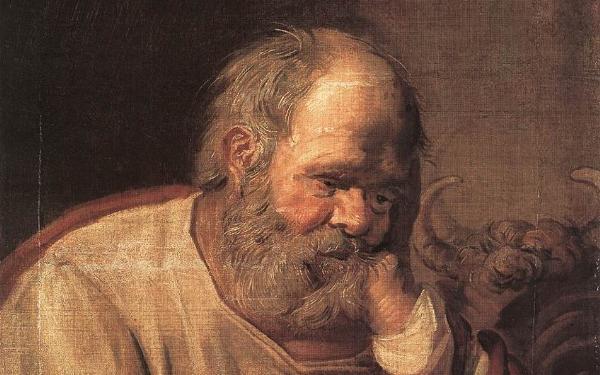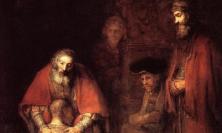Over the coming weeks, Fr Jack Mahoney will be guiding us on our journey through Lent as he looks in depth at the gospel reading for each Sunday during the season. As we prepare for Ash Wednesday, Fr Mahoney examines the significance of traditional Lenten observances and introduces us to the person and theology of St Luke, whose gospel will be the basis of much of our reflection this Lent.
We have reached that time of the year when the Church invites us over the next few weeks to associate ourselves in a special way with Our Lord, as we recall how the opposition to his teaching mounted and he was put to death, and then three days later rose from the dead. This period, which we know in English as Lent, deriving from the Middle English term meaning ‘day-lengthening’ or springtime, is known in German as Fastenzeit, a time of fasting; in French as carême; Italian as quaresima;and Spanishas cuaresma, these all deriving from the Latin quadragesima, meaning ‘fortieth’. Put these together and we end up with a definition of Lent as the Church’s traditional period given over to fasting and penance for forty days in the springtime, in preparation for Easter.
In the early Church this was the time preferred for instructing and preparing adult candidates for baptism and receiving them into the body of the faithful at the Easter Vigil. It was also the time of year, before private confession developed, during which grave sinners did penance and were prepared to be reconciled to the Church at Easter. Gradually this idea of preparation and penance spread to all the faithful, so that Lent became a penitential period for everyone in the Church, in which they renewed themselves spiritually and prepared to celebrate the feast of Christ’s resurrection at Easter. The forty days were intended to imitate the forty days and nights which we are told Jesus spent in prayer and fasting in the desert preparing for his public ministry (Lk 4:1-2). Preceding that were the examples of Elijah and Moses spending forty days in prayer, and also the period of forty years that the people of Israel spent in the Sinai desert as religious refugees from Egypt, being prepared by God to be given the Promised Land.
Fasting and abstinence
As part of this annual spiritual spring-cleaning in preparation to celebrate Easter with the risen Lord, the Church in the thirteenth century introduced the idea of ‘Easter duties’, with everyone bound to go to confession at least once a year – on the pessimistic presumption that everyone would commit at least one mortal sin a year – and to receive Holy Communion at least at Easter time. This was the origin of the day before the start of Lent becoming known in England as ‘Shrove Tuesday’, from ‘shriving’ or absolving from sins. This was the time also celebrated as carnival, from the Latin carni vale, meaning ‘farewell to flesh.’ This, it may be noted, was wishing goodbye to meat, not goodbye to ‘the flesh’, so the familiar scenes of Rio de Janeiro are not exactly what were originally intended by ‘carnival’! In France the day was also known as mardi gras, ‘fat Tuesday’, not to advocate overeating but as a reference to this being the day on which people used up all the fat and eggs in the house before taking on the serious business of the Lenten fast, which started the following day on Ash Wednesday. In England the day gained the name of ‘Pancake Day’ for the same reason. Since Sundays were exempt from Lenten penance, as the day of Christ’s resurrection, the total of forty days was made up by adding the six weeks of Lent, minus Sundays, to the four days before the first Sunday, beginning with Ash Wednesday.
Lenten fasting was often quite rigorous and sustained; it regularly involved eating just one meal a day, and it remained central to the idea of Lent for centuries. More publicly noticeable was the practice of abstaining from certain types of food, especially meat but also often eggs and milk products, and sometimes even fish. Traditionally for Catholics every Friday in the year was observed, in memory of the suffering of Jesus on that day, as a time for abstaining from ‘flesh meat’, and ‘fish on Friday’ was recognised as the distinguishing mark of Catholics. Since the time of Pope Paul VI, however, the sole relics of the old rigorous Lenten practices of fasting and abstinence expected of Catholics are the two symbolic days at the beginning and the end of Lent: Ash Wednesday and Good Friday.
Other so-called ‘penitential’ practices of additional prayers and works of charity were also regularly undertaken during Lent, as instances of ‘self-denial’. The idea of giving something up for Lent was commonplace, providing a continual, even if trivial reminder of the themes of penance or at least discomfort, and of preparing for Easter. This practice typically ranges from giving up sweets or sugar in one’s tea, to abstaining from alcohol or from various types of entertainment. In addition to the idea of ‘giving something up’, people were also encouraged, more positively, to ‘take something on’ for the six weeks of Lent, such as attending weekday Mass or the evening devotion of the Stations of the Cross, or considering various ways of helping people in their need. These Lenten practices are often described as ‘acts of self-denial’, when we ‘deny’ or deprive ourselves of some minor comfort or convenience or take on a minimal discomfort. But, of course, as Calvin pointed out, these instances of ‘denying ourselves something’ count little unless they are seen as reminders to us of the need to deny ourselves (see Luke 9:23), helping to shift our attention away from self-centredness and directing it towards the Lord and other people.
Lenten liturgies
The liturgy of Lent is traditionally highly symbolic, reminding worshippers that this is a time for concentrating on the suffering, death and resurrection of Jesus. There is the receiving of ashes on Ash Wednesday; the emptying of the holy water stoups; the dropping of the joyful Alleluia verse and the Gloria prayer at Mass; choosing the penitential purple for vestments; covering up statues of the saints during Holy Week; and kissing the cross on Good Friday. The readings at Lenten Masses are chosen to keep us particularly mindful of the spirit of the whole season and to help us cultivate a spirit of penance, reminding us of who is in charge in our lives, as we prepare to celebrate the rising of Jesus from death.
Since the Second Vatican Council, a three-year cycle of Sunday readings covering all of the Gospels has been followed at Mass to enrich the faithful. All four gospels end with an account of the Passion and Resurrection of Our Lord, but before that each of them presents a different selection from the oral traditions that circulated in the early Christian community about Jesus and his teaching. The oldest written gospel account that we possess is probably that of St Mark, and this was then used and adapted separately in St Matthew’s Gospel and St Luke’s Gospel. These two gospels also shared another written source which we do not possess today but which we can infer and refer to as ‘Q’, the German term for ‘source’. These three ‘synoptic’ gospels were followed later by what we call the Fourth Gospel, which is traditionally ascribed to St John and which contains less narrative about Jesus’s actions and more meditation on the mysteries of his life.
Following Saint Luke
This year it is St Luke’s Gospel on which we concentrate at Sunday Mass, and during Lent especially this gives us a valuable opportunity to reflect on St Luke’s own theology as he chooses what to tell us about Jesus in his gospel. In addition to knowing St Mark’s Gospel and the Q source, he also had other sources to draw on (sometimes referred to as ‘L’). As he wrote at the beginning of his gospel, he had investigated ‘many’ other available accounts of Jesus’s life and activities, including eyewitnesses, before writing his own account (Lk 1:1-3).
It is generally agreed among scholars that Luke was not Jewish, but a second or third generation Gentile Christian (see Col 4:11); that he came from the city of Antioch in Syria; that he was a very accomplished writer and editor; and he had composed his gospel by the late 80s. His concern was to address mainly educated Gentile readers, leaving out material which would interest only Jews, and he shows a disposition to commend Christianity to the Roman authorities of his day and therefore to present Roman officials in as sympathetic a light as he could, finding the Jewish synagogue in his time more hostile to his fellow Christians. He is traditionally connected with the Luke described by St Paul as a ‘fellow-worker’ (Phil 1:24) and referred to by him as ‘Luke, the beloved physician’ (Col 4:14), who was at one time the only one with Paul (2 Tim 4:11). He is also taken to be included in the well-known ‘we’ passages which suddenly appear in the Acts of the Apostles (e.g., Acts 16:10-17) and which indicate that he accompanied Paul for some time on his missionary journeys around the Christian communities in the Mediterranean.
Themes to look out for in Luke’s Gospel include his stressing of the prayer life of Jesus (see Lk 6:12), and his emphasis on the action of the Holy Spirit on Jesus (see 4:1 and 14; 10:21) and also on believers in Luke’s second volume, the Acts of the Apostles, which provides a history of the very early Church and is sometimes known as the Acts of the Holy Spirit. He shows his own sympathetic temperament – there is a tradition that he was a doctor – in bringing out the gentleness and thoughtfulness of Jesus and showing him as paying special attention to the disadvantaged in society, especially the lost, the sick and the poor, and to women. Only Luke provides the touching details of the birth of Jesus in Bethlehem (2:4-21), the parable of the compassionate Good Samaritan (10:25-37), the parable of the Prodigal and penitent Son (15:11-32), and the story of the good thief welcomed into paradise at the last minute (23:39-43). He likes to bring out reversals or striking contrasts in fortune between the haves and the have-nots, between the self-sufficient and the needy and outcast: the latter are shown as particularly beloved of God, as in the prayer of Zechariah about John the Baptist (1:67-79), the Magnificat of Mary (1:46-55), the story of the rich man and Lazarus (16:19-31) and other passages. He also provides a Sermon on the Plain (6:17-49), corresponding to Matthew’s Sermon on the Mount (Mt 5-7), presenting his own versions of the beatitudes; and he tends to soften Jesus’s criticisms of his disciples, which we find in Mark’s earlier Gospel (8:25; see Mk 4:40).
A fresh start
Keeping Lent can be seen as a time for a fresh start in our spiritual and religious lives. The liturgical readings, especially the Sunday gospels taken from Luke’s Gospel, can be seen as having been chosen to remind, inspire and encourage us to reflect on our lives, to examine our behaviour and also to think of doing something special as we prepare for the joy of Easter. This last option can topically and fashionably, but genuinely include concern for environmental matters taken up in a spirit of repentance and self-denial. Many years ago the distinguished American Jesuit moralist, Richard McCormick suggested that ‘today’s penitential practice should be ecological restraint.’ Lent is also a period during which we follow Christ in his journey towards the Cross and the Resurrection, as we recall what he did for us. This is what makes it a time to suspend some of our ordinary activities, such as watching television, in favour of increasing the time we give to prayer and to reading about our faith, either alone or in company with others.
I find the special Mass prefaces in the Missal particularly helpful in capturing the atmosphere of the various feasts or events with which they are connected, and the second Preface for Lent is no exception. Its different phrases all deserve our careful notice:
This great season of grace
is your gift to your family
to renew us in spirit.
You give us strength
to purify our hearts,
to control our desires,
and so to serve you in freedom.
You teach us how to live in this passing world,
with our hearts set on the world which will never end.
During this Lent, I shall be offering a series of reflections on the Sunday Gospels, which are mostly taken from St Luke’s Gospel:
· The temptation of Jesus
· The transfiguration of Jesus
· The need to repent or perish
· The prodigal son and his jealous brother
· The adulteress forgiven by Jesus (not in Luke, but in John 8:1-11)
· The Passion according to Luke
· The Resurrection according to Luke
These will give us the opportunity to keep Lent with St Luke and to follow his lead, as we think and pray and grieve about the closing days of Jesus’s earthly life, and prepare to share with him what Helen Waddell, translating Peter Abelard, called ‘the laughter of thine Easter Day.’
Jack Mahoney SJ is Emeritus Professor of Moral and Social Theology in the University of London and author of The Making of Moral Theology: A Study of the Roman Catholic Tradition, Oxford, 1987.






